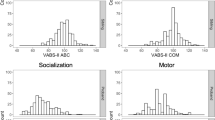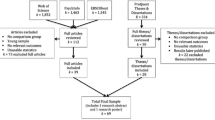Abstract
Among typically developing children, having sibling relationships promotes the development of social skills. This is a retrospective study of the effect of having sibling/s on the severity of the clinical presentation of autism spectrum disorder (ASD). The study included 112 children, 99 males and 15 females, mean age 29.6 ± 9.2 months, diagnosed with ASD. The study population was composed of a group of children with ASD who had older typically developing sibling/s (n = 56) pair-matched for age and cognitive level to a group of children with ASD without sibling/s. Each participant underwent a comprehensive assessment using standardized tests. The group with older sibling/s had less severe observed social deficits (Autism Diagnostic Observation Schedule-Social Affect calibrated severity scales [ADOS-SA-CSS]) and fewer reported non-verbal communication impairments (Autism Diagnostic Interview-Revised [ADI-R]). Regression analyses revealed that, for the ADOS-SA-CSS, higher cognitive level and having older sibling/s were associated with less severe observed social affect deficits. This model explained 32.0 % of the variance. For the ADI-R communication scores, older age, higher cognitive level and having older sibling/s were associated with less severe reported non-verbal communication impairments. This model explained 33.0 % of the variance. The main finding in this study is that a familial factor, specifically having older sibling/s, was associated with better social communication abilities in children with ASD, in addition to age and cognitive ability. Having sibling/s may offer opportunities for the child with ASD to experience social interactions with children and to acquire communication skills.
Similar content being viewed by others
References
Akerly, M. S. (1984). Developmental changes in families with autistic children: a parents perspective. In E. Scholer & G. B. Mostbov (Eds.), The effects of autism in the family (pp. 85–98). New York: Plenum Press.
American Psychiatric Association (2000). Diagnostic and statistical manual of mental disorders, revised. (4th Ed.). Washington, DC.
American Psychiatric Association. (2013). Diagnostic and statistical manual of mental disorders (5th ed.). Washington, DC: Author.
Bayley, N. (1993). Bayley scales for infant development (2nd ed.). San Antonio: Psychological Corporation.
Beckman, P., Lieber, J., & Strong, B. (1993). Influence of social partner on interactions of toddlers with disabilities: comparison of interactions with mothers and familiar playmates. American Journal of Mental Retardation, 98, 378–389.
Ben Itzchak, E., Lahat, E., Burgin, R., & Zachor, D. A. (2007). Cognitive, behavior and intervention outcome in young children with autism. Research in Developmental Disabilities, 29, 447–458.
Bowlby, J. (1973). Attachment and loss: vol. 2. separation: Anxiety and anger. New York: Basic Books.
Brewton, C. M., Nowell, K. P., Lasala, M. W., & Goin-Kochel, R. P. (2012). Relationship between the social functioning of children with autism spectrum disorders and their siblings’ competencies/problem behaviors. Research in Autism Spectrum Disorders, 6, 646–653.
Camaioni, L., Perucchini, P., Bellagamba, F., & Colonnesi, C. (2004). The role of declarative pointing in developing a theory of mind. Infancy, 5, 291–308.
Castorina, L. L., & Negri, L. M. (2011). The inclusion of siblings in social skills training groups for boys with Asperger syndrome. Journal of Autism and Developmental Disorders, 41, 73–81.
Davis, N. O., & Carter, A. S. (2008). Parenting stress in mothers and fathers of toddlers with autism spectrum disorders: associations with child characteristics. Journal of Autism and Developmental Disorders, 38, 1278–1291.
Dawson, G., Rogers, S., Munson, J., Smith, M., Winter, J., Greenson, J., Donaldson, A., & Varley, J. (2010). Randomized, controlled trial of an intervention for toddlers with autism: the Early Start Denver Model. Pediatrics, 125, e17–e23.
El-Ghoroury, N. H., & Romanczyk, R. G. (1999). Play interactions of family members towards children with autism. Journal of Autism and Developmental Disorders, 29, 249–258.
Ferraioli, S. J., Hansford, A., & Harris, S. L. (2012). Benefits of including siblings in the treatment of autism spectrum disorders. Cognitive and Behavioral Practice, 19, 413–422.
Frith, U., & Frith, C. D. (2003). Development and neurophysiology of mentalizing. Philosophical Transactions of the Royal Society of London, Series B: Biological Sciences, 358, 459–473.
Gotham, K., Pickles, A., & Lord, C. (2009). Standardizing ADOS scores for a measure of severity in autism spectrum disorders. Journal of Autism and Developmental Disorders, 39, 693–705.
Guralnick, M. J. (1986). The peer relations of young handicapped and nonhandicapped children. In P. S. Strain, M. J. Guralnick, & H. M. Walker (Eds.), Children’s social behavior: Development, assessment, and modification (pp. 93–140). New York: Academic.
Hughes, C., & Leekam, S. (2004). What are the links between theory of mind and social relations? review, reflections and new directions for studies of typical and atypical development. Social Development, 13, 590–619.
Hus, V., Gotham, K., & Lord, C. (2014). Standardizing ADOS domain scores: separating severity of social affect and restricted and repetitive behaviors. Journal of Autism and Developmental Disorders, 44, 2400–2412.
Jones, E. A., & Carr, E. G. (2004). Joint attention in children with autism: theory and intervention. Focus on Autism and Other Developmental Disabilities, 19, 13–26.
Joseph, M., Tager-Flusberg, H., & Lord, C. (2002). Cognitive profiles and social–communicative functioning in children with autism spectrum disorder. Journal of Child Psychology and Psychiatry, 43, 807–821.
Knott, F., Lewis, C., & Williams, T. (2007). Sibling interaction of children with autism: development over 12 months. Journal of Autism and Developmental Disorders, 37, 1987–1995.
Korkmaz, B. (2011). Theory of mind and neurodevelopmental disorders in childhood. Pediatric Research, 69, 101–108.
Le Couteur, A., Lord, C., & Rutter, M. (2003). The Autism Diagnostic Interview-Revised (ADI-R). Los Angeles: Western Psychological Services.
Lord, C., Rutter, M., DiLavore, P. C., & Risi, S. (1999). Autism diagnostic observation schedule V generic. Los Angeles: Western Psychological Services.
Matthews, N. L., Goldberg, W. A., & Lukowski, A. F. (2013). Theory of mind in children with autism spectrum disorder: do siblings matter? Autism Research, 6, 443–453.
McGee, G., Feldman, R., & Morrier, M. (1997). Benchmarks of social treatment for children with autism. Journal of Autism and Developmental Disorders, 27, 353–364.
Meins, E., Ferhyhough, C. M., Russel, J., & Clark-Carter, D. (1998). Security of attachment as a predictor of symbolic and mentalising abilities. Social Development, 7, 1–24.
Mullen, E. (1995). The Mullen scales of early learning. Circle Pines: American Guidance Service.
Natsuaki, M. N., Ge, X., Reiss, D., & Neiderhiser, J. M. (2009). Aggressive behavior between siblings and the development of externalizing problems: evidence from a genetically sensitive study. Developmental Psychology, 45, 1009–1018.
O’Brien, K., Slaughter, V., & Peterson, C. C. (2011). Sibling influences on theory of mind development for children with ASD. Journal of Child Psychology and Psychiatry, and Allied Disciplines, 52, 713–719.
Oppenheim-Leaf, M. L., Leaf, J. B., Dozier, C., Sheldon, J. B., & Sherman, J. A. (2012). Teaching typically developing children to promote social play with their siblings with autism. Research in Autism Spectrum Disorders, 6, 777–791.
Perner, J., Ruffman, T., & Leekam, S. R. (1994). ToM is contagious: you catch it from your sibs. Child Development, 65, 1228–1238.
Peterson, C. (2014). Theory of mind understanding and empathic behavior in children with autism spectrum disorders. International Journal of Developmental Neuroscience, 39, 16–21.
Peterson, C., & Slaughter, V. (2003). Opening windows into the mind: mothers’ preferences for mental state explanations and children’s theory of mind. Cognitive Development, 18, 399–429.
Prime, H., Pauker, S., Plamondon, A., Perlman, M., & Jenkins, J. (2014). Sibship size, sibling, cognitive sensitivity, and children’s receptive vocabulary. Pediatrics, 133, e394–401.
Ruffman, T., Perner, J., & Parkin, L. (1999). How parenting style affects false belief understanding. Social Development, 8, 394–410.
Ruffman, T., Slade, L., & Crowe, E. (2002). The relation between children’s and mothers’ mental state language and theory-of-mind understanding. Child Development, 73, 734–751.
Sallows, G. O., & Graupner, T. D. (2005). Intensive behavioral treatment for children with autism: four-year outcome and predictors. American Journal of Mental Retardation, 110, 417–438.
Schaaf, C. P., & Zoghbi, H. Y. (2011). Solving the autism puzzle a few pieces at a time. Neuron, 70, 806–808.
Shivers, C. M., & Plavnick, J. B. (2015). Sibling involvement in interventions for individuals with autism spectrum disorders: a systematic review. Journal of Autism and Developmental Disorders, 45, 685–696.
Sparrow, S., Balla, D., & Cicchetti, D. (1984). Vineland adaptive behavior scales. Circle Pines: American Guidance Services.
Thorndike, R. M., Hagen, E. P., & Sattler, J. M. (1986). Stanford-Binet intelligence scale (4th ed.). Itasca: Riverside Publishing.
Tomasello, M., Carpenter, M., Call, J., Behne, T., & Moll, H. (2005). Understanding and sharing intentions: the origins of cultural cognition. Behavioral and Brain Sciences, 28, 675–691.
Tsao, L. L., & Odom, S. L. (2006). Sibling-mediated social interaction intervention for young children with autism. Topics in Early Childhood Special Education, 26, 106–123.
Walton, K. M., & Ingersoll, B. R. (2012). Evaluation of a sibling mediated imitation intervention for young children with autism. Journal of Positive Behavior Interventions, 14, 241–253.
Wechsler, D. (1989). Wechsler preschool and primary scale of intelligence-revised. New York: The Psychological Corporation.
Wright, C. R., & Mahfoud, J. (2012). A child centered exploration of the relevance of family and friends to theory of mind development. Scandinavian Journal of Psychology, 53, 32–40.
Author information
Authors and Affiliations
Corresponding author
Ethics declarations
Conflict of Interest
Author Esther Ben-Itzchak declares that she has no conflict of interest. Author Gil Zukerman declares that he has no conflict of interest. Author Ditza A. Zachor declares that she has no conflict of interest.
Ethical Approval
All procedures performed in studies involving human participants were in accordance with the ethical standards of the institutional and/or national research committee and with the 1964 Helsinki declaration and its later amendments or comparable ethical standards.
This research was approved by the Institutional Review Board (IRB) of the medical center as required. Since it was a retrospective study based on information from the participants’ charts, the IRB did not require parental consent.
Rights and permissions
About this article
Cite this article
Ben-Itzchak, E., Zukerman, G. & Zachor, D.A. Having Older Siblings is Associated with Less Severe Social Communication Symptoms in Young Children with Autism Spectrum Disorder. J Abnorm Child Psychol 44, 1613–1620 (2016). https://doi.org/10.1007/s10802-016-0133-0
Published:
Issue Date:
DOI: https://doi.org/10.1007/s10802-016-0133-0




